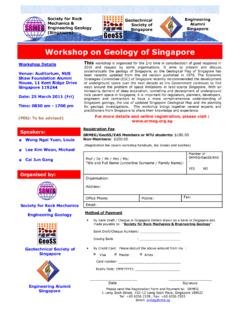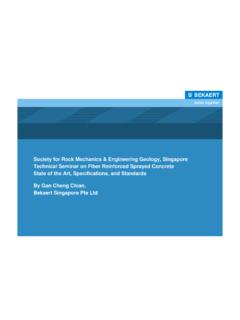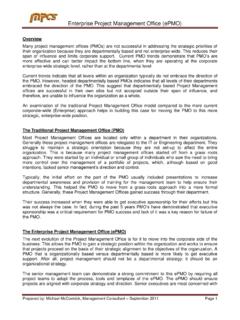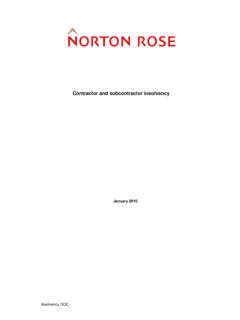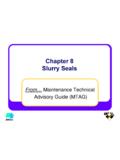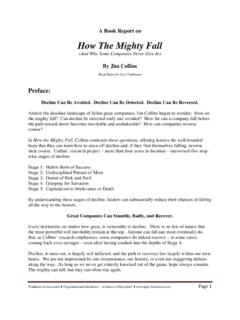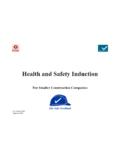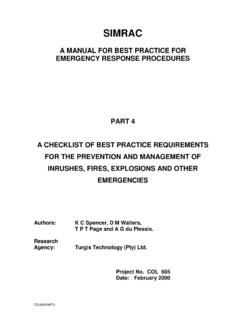Transcription of Construction safety in hard rock tunnelling …
1 Construction safety in hard rockTunnellingDr Zhou YingxinProgramme Manager (Underground Technology & Rock Engineering)Defence Science & Technology AgencyMethod of Construction Drill and Blast Method Method of rock cavern excavation with the use ofexplosives. Most suitable for hard rock with complex layoutand geometry Unique hazards due to need for blasting Work is carried out in a cyclic mannerDrillingChargingBlastingVentilatio nMucking outShotcreteRockboltSurveyThe Tunnel CycleScalingFactors Unique to tunnelling Uncertainty in the nature and variability of groundconditions (rock quality, ground water, gas, etc) -need for adequate site investigations prior to andvigilance during tunnelling Confined space of tunnel environment (limitedaccess, escape, air quality control) Difficulty in communications (sound and signalbarriers) Work in compressed air (soft ground)Types of Emergency Ground collapse (need we say more?)
2 Support failure Flooding Gas explosion Oxygen deficiency Fire (encountering inflammable gas) Accidents : moving plants Plant and power failure StoppagesPrincipal Causes of Accidents Falling from heights or falling on level (tripping/slipping) Materials falling from height or from stacks or vehicles Burial by fall of material (rock collapse or stacking collapse) Flooding or inrush of water Machinery related (cranes, excavators, etc) Vehicles (excavators, dump trucks) Electrical installations Fire and explosions (gas and explosives) Air pollution (oxygen deficiency, toxic fumes & radon gas)Hazards Related to Blasting Blasting a way of life in hard rock tunnelling Fly rock Airblast and ground shock Toxic fumes Accidental explosionsDrilling of Charge HolesWarning sign to cordon offpeople from drilling faceHazards Being knocked over/crushed rock fall dust and noiseProtection Keep away from danger area wet drilling hearing protectionCharging ExplosivesHazards accidental detonation by drillinginto explosives being knocked over or crushed bydrilling boom fallingProtection Only charge after the whole facehas been drilled work can only be carried out undersupervision of authorised blastingspecialist use working platforms Bulk emulsionMobile Charging UnitDuring ChargingShotfirer will check final
3 Chargedface before leavingSigns to warn and cordon off personnelfrom charged facePre-Blasting Responsibilities of Shot-firer in Mandai Connecting the explosive charges Final checking before blasting Work with Tunnel Foremen & safety Supervisor toensure adequate safety measures are vehicle with light sirenevacuating personnel in cavernAmple warning ( sirens) outsidethe cavernsBlastingHazards Fly rock and airblast toxic fumesProtection keep away from area switch off ventilation completely before firing switch on ventilation at full capacity after blasting evacuate team or provide shelter(containers orniches)Use of rubber-tyre mats and concrete blocks to minimiserock throw during blasting open areasInspection of Blast Results Check for Misfires, Dangerous and Loose RocksConditions Shotfirer and Tunnel Foreman will inspect the areacautiously for dangerous signs safety Supervisor to ensure SF/TF carry out inspection Should there be no initiation of explosives, minimumre-entry time must not be less than 30 mins.
4 After initiation, minimum retry time must not be lessthan 15mins (after ventilation) Blast inspection team shall enter tunnel withappropriate breathing Storage Licensed magazine to store detonators andbooster charges in temp cavern on site Reduced transport hazards to publicUse of Bulk Emulsion Non-explosives until being charged. Less toxic fumes Mechanised charging minimises humanexposure at drilling faceMobile Charging UnitUse of ExplosivesDetonators stored in cavernStorage magazine guarded by 24hour Cisco guardsControl of Dust and Fumes Ventilation Gas/dust monitoring Minimum entry time after blasting (withventilation)Air Quality Underground Oxygen deficiency Dust Toxic gas (CO, CO2, NO) Heat and fire Parameters for Air Monitoring Oxygen to 23% Nitrogen Dioxide Less than 5ppm Lower Explosive Limit Less than 10% Carbon Monoxide Less than 25ppm Dust Less than 10mg/m3 (Long term)Measurement Limits for AirTime of thedayO2(%)NO2(PPM)LEL(%)CO(PPM)
5 *1-52-55-21**During mucking-out operation, the levels ofNO2 and CO tends to be higherTypical Results in Tunnels (Average readings after blasting)Radon Gas Underground Naturally occurring in rock and soil Radon and radon daughters are radioactive andcan cause adverse health effects (lung cancer) Is released by exposed surface, blasted rock,groundwater, from outside air Conditions improve with proper ventilationRadon Level a Lifetime Risk of Lung Cancer Death (per person) from Radon Exposure in Homes bpCi/LNever SmokersCurrent Smokers cGeneral Population2036 out of 1,00026 out of 10011 out of 1001018 out of 1,00015 out of 10056 out of 1,000815 out of 1,00012 out of 10045 out of 1,000473 out of 10,00062 out of 1,00023 out of 1,000237 out of 10,00032 out of 1,00012 out of 1, out of 10,00020 out of 1,00073 out of 10, out of 100,00064 out of 10,00023 out of 10,000a Assumes constant lifetime exposure in homes at these Estimates are subject to uncertainties as discussed in Chapter VIII of the risk Note: BEIR VI did not specify excess relative risks for current : US EPA WebsiteRadon Gas Underground Measured levels in UAF: - Bq/m3 Internationally accepted levels.
6 200-500 Bq/m3 1 pCi/L= 37 Bq/m3 Hazards Being struck or crushed Falling Material Dust and Noise Tripping and fallingProtection Do not enter into loading area Keep running surface in goodcondition Do not overload dumper Good lighting to work areaMucking OutHazards Rock fall Collapse as result from instability ofexposed rock surfaceProtection Use machine for rock scaling Do not enter danger zone beforescaling is completed Lighting adequatelyScalingManual ScalingHazards Rock fall Falling from heights Being crushedProtection Only work from a safe area Use working platforms Light the area adequatelyInstalling Rock BoltsHazards Falling from heights NoiseProtection Use working platforms Use eye and hearing protectionShotcretingHazards Falling from heights Rebound & dust Chemical additivesProtection Use working baskets Use protective clothing Use shotcrete robot where possible Wear protective hardhat for shortcreting Wear respiratory protectionShotcreting RobotsHazards Being crushed Rebound & dust Burst of concrete hoseProtection Do not enter danger zone Distance between nozzle & wall < Wear shotcrete protective helmet Wear respiratory protection Wet mix with alkali free additive toreduce dust & air pollutionRock Support as SafetyMeasures for Construction Use of CT-Bolts Easier to install than normalrebar bolts Faster installation hence costefficient Adoption of Rock Support System Permanent rock bolts
7 Designadopted during constructionphase All tunnel crown sprayed withshotcrete to reduce hazards ofspalling rocks Shotcrete used as temporarysupport for safetySafety Management Planat UAF Site Job Hazard Analysis For the various activities in the Tunnel Cycle, a detailed JobHazard Analysis is carried out where all the potential hazards areidentified for each work activity safety Procedures For each of the Job Hazards in each Construction phase identified, safety procedures have been identified for work personnel toadopt. safety Control safety control measures are then put in place to minimise oravoid the job hazards regular safety meetings, briefings,seminars & audits. safety Review Contractor together with the Client conducts regular review of theSafety Measures.
8 safety is also standing agenda item in bi-weekly co-ordination meetings Improvements Corrective measures and improvements are done where thereare Management Planat UAF SiteCommunications, Communications! Active participation of site team incontractor s weekly safetymeetings safety & health a standing item inbiweekly co-ordination meetinginvolving DSTA programmeManagers, QP s, and contractorsproject managers Everybody s an expert/student(training conducted by DSTA,specialists, and contractors)UAF OHSE Organisation ChartSECM anagementRepClient(DSTA)SafetyManagerAss t. ProjectManagerSubcon sSafety SupSafetySupervisorTunnelManagerProjectM anagerSafetyOfficer/ ECOT unnel TeamTunnelEngineer/ForemenSurveyTeamM&E TeamSystem safety A systematic process of identifying, evaluating,and controlling all hazards throughout the lifecycle of a project or system ( safety influencesdesign and Construction ) Application of engineering and managementprinciples, criteria and techniques to optimisesafety (compare to compliance safety )
9 System safety Objectives To achieve maximum safety within theconstraints of operational effectiveness, time,and money Should preferably be incorporated at theinception of a projectSafety Principles Absolute safety does not exist safety must be planned safety is everybody s responsibility safety efforts cost money, so do accidents (or ifyou think safety is expensive, try an accident!)CostR is kSafety Design Precedence Design to eliminate hazard if possible Design to reduce hazard Incorporate safety devices Provide warning devices Develop procedures and trainingSystem safety Activities Preliminary hazard identification Preliminary hazard analysis Sub-system hazard analysis System hazard analysis Operating hazards analysis Occupational health and hazards assessment Software hazards analysis Hazard tracking1 5 HighR16 9 SeriousR210 17 MediumR318 - 20 LowR4 SeverityProbabilityCatastrophicCriticalM arginalNegligibleFrequent13713 Probable25916 Occasional461118 Remote8101419 Improbable12151720 Risk RankingImportant.
10 Need to definerisk acceptance authorityRisk Acceptance CriteriaExample from US MIL STD 882 R1 - Unacceptable R2 - Must control or mitigate R3 - Acceptable with management review R4 - Acceptable without reviewSafety and Health RiskManagement (MOSHAB, 1999)Risk =Likelihood x ConsequenceRisk Mitigation - the ALARP principle - As Low AsReasonably PracticableGeneric Mitigators for High-Consequence Industries Public dread & resultant imposed pressure Organisation s clear understanding of the price to pay in getting it wrong Organisational commitment to a strong safety culture Organisational commitment to continued investment in relevant technicalexpertise Independence and empowerment of safety mechanisms Organisational commitment to allocating some of the best brains tosafety Visibility to and encouragement for external challenge Formal external regulation Encouragement and recognition of early symptoms/near-missreporting/no-blame culture

